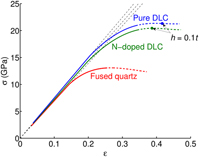Crossref Citations
This article has been cited by the following publications. This list is generated based on data provided by
Crossref.
Samaei, Arash
and
Chaudhuri, Santanu
2021.
Mechanical performance of zirconia-silica bilayer coating on aluminum alloys with varying porosities: Deep learning and microstructure-based FEM.
Materials & Design,
Vol. 207,
Issue. ,
p.
109860.
Bakhti, Hamzah
Weyrich, Thomas
Es-Souni, Martha
Laghrissi, Ayoub
and
Es-Souni, Mohammed
2021.
Non-fouling polymer films on hard-anodized aluminum substrates: Nanomechanical properties and modelling.
Progress in Organic Coatings,
Vol. 161,
Issue. ,
p.
106553.
Liang, Kang
Gao, Kunpeng
Cai, Wenqing
and
Song, Gaofeng
2022.
The Study on the Substrate Effect in the Nanoindentation Experiment of the Hybrid Material.
Advances in Civil Engineering,
Vol. 2022,
Issue. 1,
Ezenwafor, Theresa
Anye, Vitalis
Madukwe, Jonathan
Amin, Said
Obayemi, John
Odusanya, Olushola
and
Soboyejo, Winston
2023.
Nanoindentation study of the viscoelastic properties of human triple negative breast cancer tissues: Implications for mechanical biomarkers.
Acta Biomaterialia,
Vol. 158,
Issue. ,
p.
374.
Vieira, Vitor Ferreira
Shigaki, Yukio
Martins, Paulo Sérgio
Ba, Elhadji Cheikh Talibouya
and
Dias, Cádmo Augusto Rodrigues
2023.
Nanoindentation test of a DLC coated high-speed steel substrate using a two-dimensional axisymmetric finite element method.
Diamond and Related Materials,
Vol. 134,
Issue. ,
p.
109792.
Zellhofer, Manuel
Jech, Martin
Badisch, Ewald
and
Mayrhofer, Paul H
2024.
Understanding DLC system failure influenced by progressed wear.
Surface Engineering,
Vol. 40,
Issue. 5,
p.
616.
Vetter, Joshua
Hofmann, Patrick
Günther, Marcus
Holfelder, Niklas
Grosse, Stefan
and
Schmauder, Siegfried
2024.
Micromechanical investigation of DLC based coating systems by means of combined characterization and simulation methods.
Surface and Coatings Technology,
Vol. 494,
Issue. ,
p.
131424.
Sharma, Deepak
Gulati, Ishika
Singh, Saminderpreet
Tiwari, Sachin Suresh
and
Sharma, Varun
2025.
Multifunctional Ti6Al4V-xZn-yHAp/β-TCP coatings deposited by RF magnetron sputtering on additively manufactured Co-Cr-Mo-W alloys: Mechanical, corrosion, and in-vitro evaluation.
Surface and Coatings Technology,
Vol. 518,
Issue. ,
p.
132834.
Ba, Elhadji Cheikh Talibouya
de Almeida, Larissa Solano
Danelon, Miguel Rubira
Martins, Paulo Sérgio
Rossino, Luciana Sgarbi
de Siervo, Abner
de Melo Pereira, Luiza Amelia
and
Santos, Sandro Cardoso
2025.
Investigation of the structural and tribological effects of silicon and nitrogen doping in hydrogenated amorphous carbon coatings applied to AISI M35 high-speed steel substrates.
Diamond and Related Materials,
Vol. 159,
Issue. ,
p.
112902.
Karabacak, Ahmet Yesevi
Oğuz, Hatice Zor
Kart, Sevgi Özdemir
and
Kart, Hasan Hüseyin
2025.
Mechanical properties of carbon and silicon core-shell nanosprings: A molecular dynamics simulation study.
Physica B: Condensed Matter,
Vol. 716,
Issue. ,
p.
417673.


